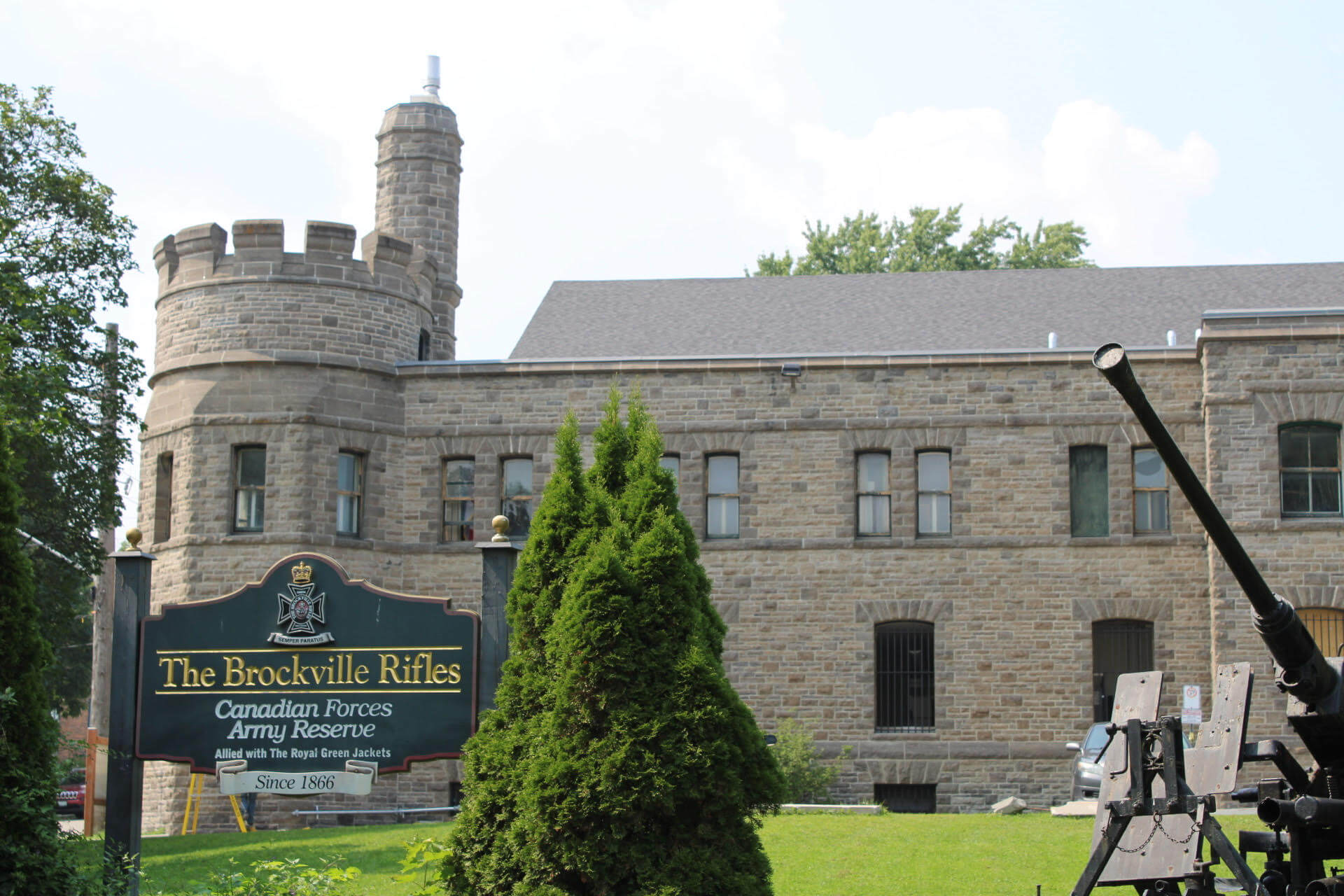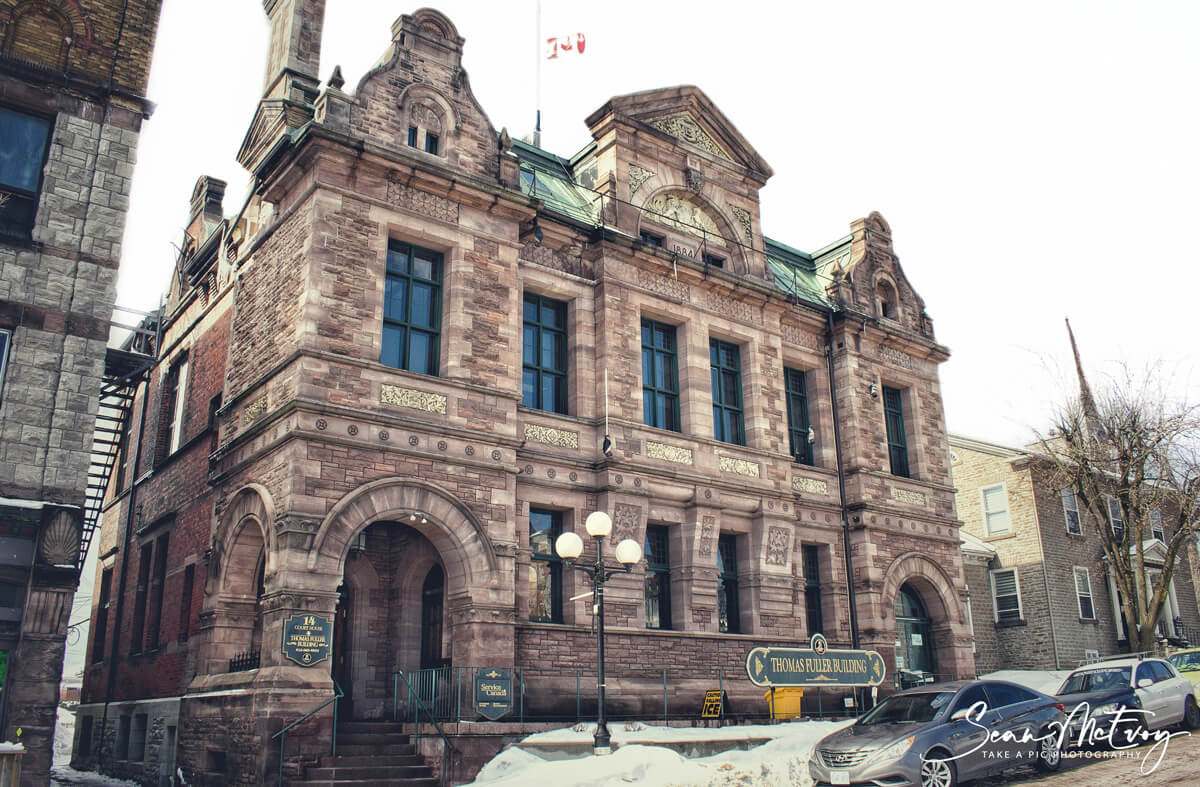Historical Spots
In 1832, Brockville became the first incorporated, self-governing town in Ontario – two years before Toronto! Our rich history runs throughout the city much like the St.Lawrence runs through our 1000 Islands. Our city’s name evokes memories of wars long past. Named after Sir Issac Brock, the great British general from the war of 1812, Brockville has history scattered throughout the downtown and waterfront, waiting for you to explore.
287 King St E, Brockville
Brockville Railway Tunnel
Walk ten feet in from the entrance and you can feel it – the temperature drops, the sunlight is behind you, and you’re surrounded by the sound of music and water dripping from the ceiling. You’re in the first railway tunnel in Canada, refurbished to its former glory (with a few modern touch-ups.)
The Brockville Railway Tunnel is open for the 2024 season! It is open 7 days/week, 9am-9pm.
The Brockville Railway Tunnel was built between 1854 and 1860 to service the Brockville and Ottawa Railway. Completed 21 years before the construction of the Canadian Pacific Railway, this historic tunnel predates all other major tunnel projects in Canada, including the rail tunnels in the western Rockies. A committee came together to renovate this historic site for the people of Brockville in 2011, and in 2017, the tunnel opened its doors to the public once again.
Accessible from either end, the Brockville Railway Tunnel is a great way to reach the waterfront and downtown core. The rails have been replaced with a smooth concrete path, and the tunnel is now lit with a state of the art LED light and sound display. Both the north and south entrances have wheelchair-accessible access, so it can be enjoyed by people of all ages and abilities.
Historic Sites & Museums
Fulford Place Museum

Enter a world of opulence, politics, tragedy, and even a little mysticism when you walk through the doors of Fulford Place. Home of Senator George Taylor Fulford, Fulford Place is a shining example of the wealth that used to live along “Millionaire’s Row”. After buying the patent for Dr. William’s “Pink Pills for Pale People”, George Fulford made a fortune. He had his mansion built between the St. Lawrence River and The King’s Highway (now known as King Street.) The gardens were designed by Frederick Olmsted of the Olmsted landscaping firm, which also designed Central Park in New York City. Be sure to check out the Italianate-style gardens, the elaborate triton fountain, statuary, stone walls and gates, all lovingly restored by the Ontario Heritage Trust. Hear stories of prime ministers who used to visit for both business and leisure, and learn about how the life of the Fulfords’ wasn’t as idyllic as it seemed after a series of deaths at the turn of the century. If you’re taking a tour through the house, be sure to ask your tour guide if they know of any good ghost stories – there are quite a few throughout the mansion!
Courthouse Square
Sitting atop the historic town square in Brockville is the Leeds and Grenville County Courthouse, or simply known as the Courthouse. Framed by churches and steeples, the Courthouse overlooks the downtown core of Brockville. Identified as a National Historic Site in 1966, this building catches your attention quickly, even from as far as the harbour, with its grandiose architecture. While you’re appreciating this neoclassical monument, be sure to look up – way up – and meet Sally Grant, Brockville’s name for our Lady Justice statue.
Brockville Museum
There’s no better way to experience this history than by visiting the Brockville Museum. With relics from Brockville’s industrial past, you can learn all about how factories ran the waterfront for decades. From carriages to cars, Pink Pills for Pale People and even Stetson hats, learn about what used to be Made in Brockville. Brockville’s evolution from an industrial town to one of recreation is also highlighted, as are all the eras in between. If you haven’t visited the Brockville Museum yet, be sure to check out their Digital Exhibits as well.
Lyn Heritage Place Museum
Lyn Heritage Place is a community museum dedicated the cultural heritage of Lyn and the surrounding area. It offers a glimpse into the history of the Village of Lyn. Local business, people, and period items are on display in our four main rooms.
19 W Main St, Lyn, ON K0E 1M0 | (613) 342-3785 | lynmuseum.ca
Fort Wellington National Historic Site
First built during the War of 1812 to defend the St. Lawrence River shipping route from attack by the United States, Fort Wellington also helped thwart another American invasion during the 1837-38 Upper and Lower Canada rebellions. Explore the wreck of an 1812-era gunboat, try on a costume and take part in military drill, witness a cannon firing, savour period treats cooked over an open fire, or play games from long ago
370 Vankoughnet St, Prescott, ON K0E 1T0 | (613) 925-2896 | pc.gc.ca/en/lhn-nhs/on/wellington
Brockville Armouries
The Brockville Rifles is a reserve infantry regiment of the Canadian Army, located in Brockville, Ontario. The Brockville Rifles is one of 15 reserve units of 33 Canadian Brigade Group, a Reserve Brigade located in Eastern and Northern Ontario. As a Primary Reserve unit, The Brockville Rifles trains part time. The regiment provides individual augmentees to support domestic and international operations conducted by soldiers in support of the Canadian Army missions.
144 King Street E | (613) 342-2755 | army-armee.forces.gc.ca

Thomas Fuller Building

On the West side of Courthouse Avenue sits Brockville’s first Post Office, completed in 1886 by the Canadian architect for the Government of Canada, Thomas Fuller. During his 15-year tenure, he supervised the design of over 140 buildings across Canada, including 80 post offices. The former Brockville Post Office is recognized as a National Historic Site of Canada.
City Hall

One of Brockville’s most iconic landmarks, Brockville City Hall. Formerly known as Victoria Hall was originally built during the 1862-64 era as a combination concert hall, office space, and indoor market house. The symbolic clock tower was recently restored to maintain the clock’s heritage value.
Castles
Boldt Castle
If you’re looking for tragic romance in a gorgeous castle, you don’t need to search far and wide – those stories happened right here in the 1000 Islands, at Boldt Castle in Alexandria Bay, New York State.
George Boldt, the hotel millionaire, began building this castle in 1900 for his beloved wife, Louise. Boldt Castle was intended to be their perfect summer home on Heart Island. It took 300 workers to create this gorgeous home, and not a single detail or expense was spared. This six story, 120 room castle included tunnels, a power house, Italian gardens, a drawbridge, a children’s playhouse known as Alster Tower, and a dove cote.
This work all stopped in January 1904 however. Louise had died suddenly, and a telegraph to the island from Boldt commanded that the workers immediately stop all construction, as he could not imagine his dream castle without the love of his life. Boldt never returned to the island, and the castle was left incomplete, at the mercy of the elements and vandals. It sat like that for 73 years. In 1977, the Thousand Islands Bridge Authority acquired Boldt Castle, and since then, all net revenue has gone to restoring the castle to its intended beauty for future generations.
1 Heart Island, Alexandria Bay, NY
Singer Castle
Originally known as “The Towers,” Singer Castle is a beautiful castle that rests just south of the Canada / USA border. Singer Castle can be found on Dark Island. Designed by the American architect Ernest Flagg, it was the last of several castles built along the 1000 Islands between 1888-1905. Frederick Bourne, the president of the Singer Sewing Machine Company at the time, had the castle built to originally be his hunting retreat for his family. The castle was built from granite that was quarried from Oak Island, with the stone ferried over by small boats between the two islands. Singer castle has 28 rooms, 4 towers, and many secret passageways throughout the building. Singer Castle remained in the Bourne family until the 1960s.
23 Blind Bay Island, Hammond, NY
